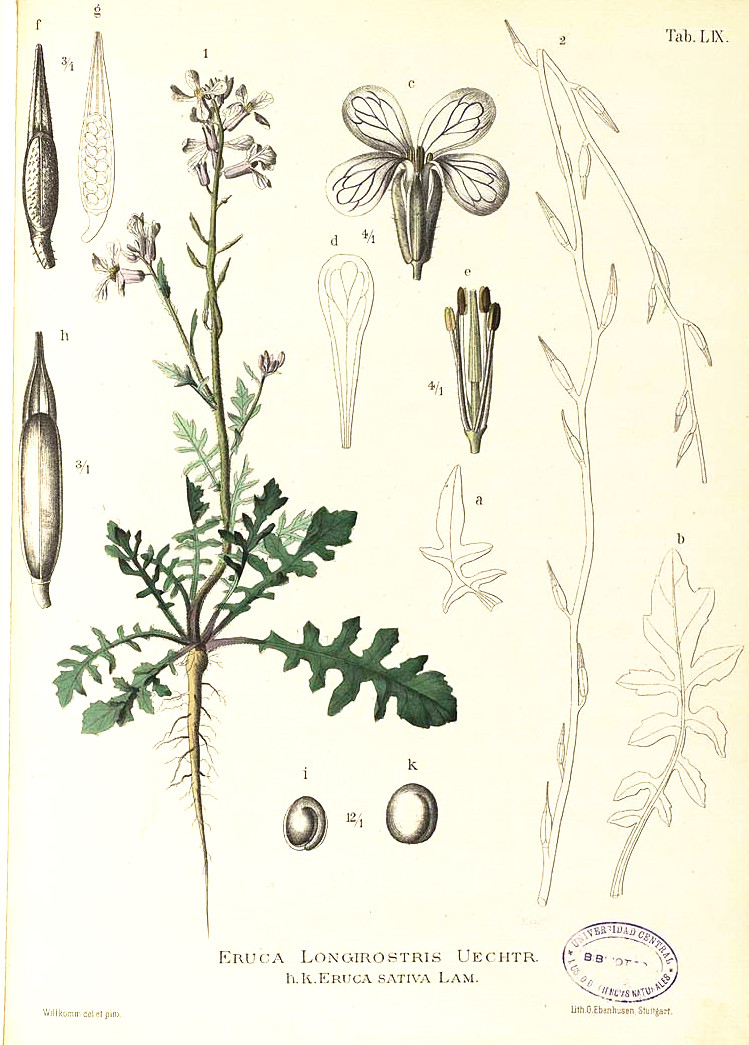Dies ist eine alte Version des Dokuments!
Eruca vesicaria (L.) Cav. subsp. sativa (Mill.) Thell. - syn.Eruca sativa Mill.; Brassica eruca L. - Brassicaceae
salad rocket, roquette, rucola, Rucola, Garten-Senfrauke, Salatrauke
Annual herb, 15-50(-100)cm high, native to the Mediterranean region, cultivated all over the world; lower leaves pinnatifid; racemes with more than 20 whitish-cream flowers, anthers obtuse; lower fruit pedicels up to 6mm. E.vesicaria includes three infraspecific taxa, all found in the wild state; ssp. sativa is the cultivated one, whereas the other two, ssp.vesicaria and ssp.pinnatifida, are only found in the West Mediterranean area.
[Pignone, D., & Gomez-Campo, C. (2011). 8.1 Basic Botany of Eruca spp. Wild Crop Relatives: Genomic and Breeding Resources: Oilseeds, 3, 149]
„It is sometimes conflated with Diplotaxis tenuifolia, the perennial wall rocket, another plant of the Brassicaceae family, which in the past was used in the same manner.“ http://en.wikipedia.org/wiki/Eruca_sativa
„The aroma compounds of rocket salad (Eruca sativa) SPME headspace samples of fresh leaves were analyzed using GC, GC−MS, and olfactometry. More than 50 constituents of the Eruca headspace could be identified to be essential volatiles, responsible for the characteristic intense green; herbal; nutty and almond-like; Brassicaceae-like (direction of cabbage, broccoli, and mustard); and horseradish-like aroma of these salad leaves. As aroma impact compounds, especially isothiocyanates, and derivatives of butane, hexane, octane, and nonane were identified. 4-Methylthiobutyl isothiocyanate (14.2%), cis-3-hexen-1-ol (11.0%), cis-3-hexenyl butanoate (10.8%), 5-methylthiopentyl isothiocyanate (9.3%), cis-3-hexenyl 2-methylbutanoate (5.4%), and 5-methylthiopentanenitrile (5.0%) were found in concentrations higher than 5.0%.“
[Aroma compound analysis of Eruca sativa (Brassicaceae) SPME headspace leaf samples using GC, GC-MS, and olfactometry. Jirovetz, L., Smith, D., & Buchbauer, G., Journal of agricultural and food chemistry, Vol.50(16), 2002, 4643-4646]
 4-methylthiobutyl isothiocyanate (cleavage product of glucoerucin)
4-methylthiobutyl isothiocyanate (cleavage product of glucoerucin)
„Rocket (Eruca sativa Mill. or Eruca vesicaria L.) is widely distributed all over the world and is usually consumed fresh (leafs or sprouts) for its typical spicy taste. Nevertheless, it is mentioned in traditional pharmacopoeia and ancient literature for several therapeutic properties, and it does contain a number of health promoting agents including carotenoids, vitamin C, fibers, flavonoids, and glucosinolates (GLs). The latter phytochemicals have recently gained attention as being the precursors of isothiocyanates (ITCs), which are released by myrosinase hydrolysis during cutting, chewing, or processing of the vegetable. ITCs are recognized as potent inducers of phase II enzymes (e.g., glutathione transferases, NAD(P)H:quinone reductase, epoxide hydrolase, etc.), which are important in the detoxification of electrophiles and protection against oxidative stress. The major GL found in rocket seeds is glucoerucin, GER (108 +/- 5 micromol g(-)(1) d.w.) that represents 95% of total GLs. The content is largely conserved in sprouts (79% of total GLs), and GER is still present to some extent in adult leaves. Unlike other GLs (e.g., glucoraphanin, the bio-precursor of sulforaphane), GER possesses good direct as well as indirect antioxidant activity.“
[Direct antioxidant activity of purified glucoerucin, the dietary secondary metabolite contained in rocket (Eruca sativa Mill.) seeds and sprouts. Barillari, J., Canistro, D., Paolini, M., Ferroni, F., Pedulli, G. F., Iori, R., & Valgimigli, L. , Journal of agricultural and food chemistry, Vol.53(7), 2005, 2475-2482]
„All of the sprouts from Italian E. sativa L. had consistently high total glucosinolate content, with only a few exceptions, and also the highest percentage contents of 4-mercaptobutylglucosinolate. In contrast, sprouts produced from Central and Eastern European seeds had a much higher percentage of 4-methylthiobutylglucosinolate. With a single exception, Tunisia, all sprouts produced from North African seeds had very high 4-methylthiobutylglucosinolate contents. The single sample from China had a high total glucosinolate content and glucosinolate profile that was very similar to the accessions from Uzbekistan and Pakistan. All of the D. tenuifolia L. sprouts had consistently high total glucosinolate contents, and a high percentage of this was 4-mercaptobutylglucosinolate.“
[Identification and quantification of glucosinolates in sprouts derived from seeds of wild Eruca sativa L.(salad rocket) and Diplotaxis tenuifolia L.(wild rocket) from diverse geographical locations. Bennett, R. N., Carvalho, R., Mellon, F. A., Eagles, J., & Rosa, E. A., Journal of agricultural and food chemistry, Vol.55(1), 2007, 67-74]
„Typical rocket salad flavour and pungency were perceived as positive sensory traits. Bitter, and especially herbaceous notes, characterised the groups of less accepted accessions. The groups classified as significantly unpleasant were characterised by high glucosinolate content, with either sinigrin (strong perceived pungency, flavour and several other additional sensory notes), or sinalbin/gluconapin (strong herbaceous note, low flavour perceived), as the dominant components… a composition rich in recognised health-promoting components (glucoerucin, glucoraphanin) were associated with higher acceptance.“
[Exploring new potential health‐promoting vegetables: glucosinolates and sensory attributes of rocket salads and related Diplotaxis and Eruca species. D'Antuono, L. F., Elementi, S., & Neri, R., Journal of the Science of Food and Agriculture, Vol.89(4), 2009, 713-722]

Willkomm, H.M., Illustrationes florae Hispaniae insularumque Balearium, vol. 1: t. 59, fig. h-k (1881-1885)
